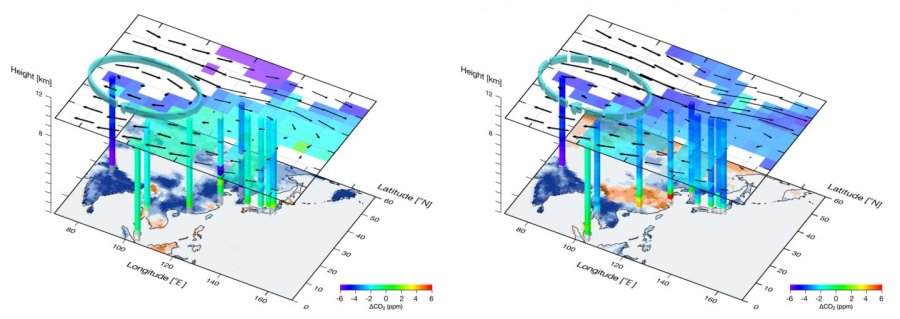[ad_1]

Three-dimensional view of the CONTRAIL CO2 observations (left August and right September). Obvious is distinct CO2 depletion within the Asian summer monsoon anticyclone (thick red arrow) and the low CO2 extends from the near-surface layers (blue pillar over Delhi, India). Colors on the upper panel indicate monthly average CO2 concentrations (atmospheric increasing trend subtracted) obtained from measurements at cruising altitudes (approx. 10 km). The black arrows show monthly averaged wind. In addition, measurements during ascent/descent over airports illustrate vertical profiles (colored pillars). The lower panel indicate CO2 emissions (red) and uptakes (blue) by the terrestrial biosphere.
Credit: CONTRAIL team
The National Institute for Environmental Studies (NIES), Japan, and Meteorological Research Institute (MRI), Japan have been conducting an atmospheric measurement project called CONTRAIL (Comprehensive Observation Network for Trace gases by Airliner). This is the world’s first program that measures atmospheric CO2 concentrations continuously on board passenger aircraft. Japan Airlines’ (JAL) aircraft regularly carry a Continuous CO2 Measuring Equipment (CME), which measures atmospheric CO2 concentrations continuously from take-off to touch down along the flight track. Since the project started in 2005, over 7 millions of CO2 data from over 12 thousands of flights have been collected worldwide, which enabled us to explore detailed spatiotemporal variations of atmospheric CO2 over Asia Pacific, the region that has been only sparsely monitored for CO2 concentration.
The study was published in Atmospheric Chemistry and Physics on October 17, 2018.
Atmospheric CO2 concentration is increasing and actions for climate change need accurate knowledge of the global carbon cycle. Asia has become increasingly important in the global carbon budget by rapidly growing economy. There are still large uncertainties in the estimates of CO2 emissions from human-related sectors and emissions and uptakes by natural vegetation in Asia. Atmospheric measurements have been useful information since abundance and gradient of CO2 in the air are essentially determined by spatiotemporal distributions and intensities of emissions and uptakes and by atmospheric transport. It has been however a challenge to establish a well-facilitated monitoring network across Asia. Commercial airliner is one practical solution, since it provides regular and long-term opportunities of flying measurements over different countries worldwide.
This study analysed 10 years of the CONTRAIL CO2 measurement data taken over Asia Pacific. From ground-based global atmospheric monitoring networks, it is now well known that atmospheric CO2 undergoes clear seasonal variation with summertime depletion and springtime elevation (in the Northern Hemisphere) due to biospheric activity (photosynthesis and respiration), and thus northern biosphere is well recognized as a driver of seasonal cycles of atmospheric CO2. The CONTRAIL data revealed clear seasonality of CO2 over Asia that varies with latitude, longitude and altitude. In particular, we observed distinct depletion of CO2 concentration over South Asia to Southeast Asia in August to September. The low CO2 area was found to be confined within the Asian summer monsoon anticyclone — persistent anticyclonic circulation in upper layers of the atmosphere (above 10 km altitude) associated with the seasonally varying monsoon regime — and to be imprinted by strong CO2 uptake by vegetation in South Asia. The Asian summer monsoon meteorology efficiently conveys signals from South Asian ground vegetation upward and it propagates eventually out to the Pacific after being trapped within the anticyclone. Seasonal evolutions of CO2 uptakes in South Asia and of dynamical development and decay of the Asian summer monsoon anticyclone have remarkable impact in distributing atmospheric CO2 over Asia and to the Pacific.
The CONTRAIL commercial airliner measurements provide high-frequency CO2 data over regions under-sampled by the current world atmospheric monitoring networks. The CONTRAIL datasets will complement measurements at other observational platforms (ground stations and satellites) and will be of increasing help to better understand carbon cycles and atmospheric transport of trace gases important in climate change and air pollution.
Story Source:
Materials provided by Institute on the Environment. Note: Content may be edited for style and length.
Journal Reference:
- Taku Umezawa, Hidekazu Matsueda, Yousuke Sawa, Yosuke Niwa, Toshinobu Machida, Lingxi Zhou. Seasonal evaluation of tropospheric CO2 over the Asia-Pacific region observed by the CONTRAIL commercial airliner measurements. Atmospheric Chemistry and Physics, 2018; 18 (20): 14851 DOI: 10.5194/acp-18-14851-2018
Cite This Page:
Institute on the Environment. “Commercial airliners reveal three-dimensional distribution of atmospheric CO2 over Asia Pacific: Seasonality of CO2 under the monsoon meteorological regime.” . , 6 November 2018. <www..com/releases/2018/11/181106104228.htm>.
Institute on the Environment. (2018, November 6). Commercial airliners reveal three-dimensional distribution of atmospheric CO2 over Asia Pacific: Seasonality of CO2 under the monsoon meteorological regime. . Retrieved November 6, 2018 from www..com/releases/2018/11/181106104228.htm
Institute on the Environment. “Commercial airliners reveal three-dimensional distribution of atmospheric CO2 over Asia Pacific: Seasonality of CO2 under the monsoon meteorological regime.” . www..com/releases/2018/11/181106104228.htm (accessed November 6, 2018).
[ad_2]















